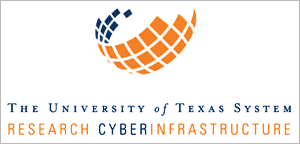UT System Research Cyberinfrastructure Initiative Projects Up and Running
 AUSTIN – The University of Texas System announced today (Feb. 1) significant progress of its Research Cyberinfrastructure Initiative (UTRC) aimed at creating a technical and cultural environment that will allow the nine academic universities and six health institutions within the System to grow computational approaches to research and support data analysis and warehousing.
AUSTIN – The University of Texas System announced today (Feb. 1) significant progress of its Research Cyberinfrastructure Initiative (UTRC) aimed at creating a technical and cultural environment that will allow the nine academic universities and six health institutions within the System to grow computational approaches to research and support data analysis and warehousing.
The initiative includes three projects: a newly upgraded, high bandwidth inter-institution network; access to high-end computing and visualization resources at the Texas Advanced Computing Center (TACC) at UT Austin; and access to a large volume and secure data repository. While the data repository is fully functional as of Feb. 1, the other two projects are at various stages of completion.
The projects – part of UT System Chancellor Francisco G. Cigarroa’s Framework for Advancing Excellence Action Plan – were funded by a $23 million allocation approved in late 2010 by the UT System Board of Regents for improvements that will increase high-performance computer connectivity and capacity across all 15 UT institutions, support research projects and foster stronger collaborations among scientists in Texas and around the world.
“This initiative is testament to the power of pooling resources and bringing together the world’s best minds to develop new resources and solutions that can directly enhance the groundbreaking research taking place across the UT System, the state, nation and the world,” UT System Executive Vice Chancellor for Health Affairs Kenneth I. Shine, M.D., said. “The Board of Regents and Chancellor Francisco Cigarroa should be applauded for supporting these projects which will increase the System’s overall computational analysis capabilities and will undoubtedly play an integral role in finding new discoveries in the laboratory.”
The network upgrades will enable UT System institutions to transmit and receive data at a rate of 10 gigabits per second through an intra-system connection. The enhancements also will improve collaborations with researchers in other countries as well as with investigators at other universities in Texas.
William Weems, assistant vice president for academic technology and the associate medical school dean at the UT Health Science Center - Houston, said the computational enhancements will significantly increase space, efficiency and data storage needs, not to mention foster greater productivity.
“The ability to send large amounts of data is really critical, particularly for scientists who are doing next-generation research,” Weems said. “We need this capability to do the kinds of things necessary in medical research.”
As part of the initiative, the TACC has deployed the Lonestar 4 supercomputing system and made it available to researchers at all UT System institutions, and TACC’s world-renowned computing experts are assisting these researchers and UT System institutions with their computational research needs.
“Lonestar is one of the most powerful supercomputing systems in the world dedicated to open science research, and thus provides researchers at UT Systems with a scientific—and competitive—advantage. Our staff are supporting researchers with new projects with science, engineering, and biomedical research that will enable important new discoveries to be made here in Texas,” TACC Director Jay Boisseau said.
Additionally, the improvements will allow institutions to conduct projects using shared data storage at UT Austin and UT Arlington, which will enable multiple researchers from different sites to access a single data source. The enhancements also will provide support for state-of-the-art communications for distance learning and conferencing.
"At five petabytes of initial raw capacity, the data repository component of the UTRC will provide a highly scalable and reliable pool of storage to researchers at all UT campuses, providing a high performance solution to address the data management challenges of 21st-century research,” said Chris Jordan, leader of the Data Management and Collections group at TACC and chair of the storage committee for the UTRC initiative.
“Along with the computing capabilities of TACC's Lonestar system it will enable research to be performed on larger data sets than ever before. In combination with the high-speed network linking researchers at all the UT campuses, it will be a vehicle for research collaboration within UT System and with the world."
For more information on the UTRC, visit the website.
About The University of Texas System
The University of Texas System is one of the nation's largest higher education systems, with nine academic universities and six health institutions. The UT System has an annual operating budget of $13.1 billion (FY 2012) including $2.3 billion in sponsored programs funded by federal, state, local and private sources. Preliminary student enrollment exceeded 215,000 in the 2011 academic year. The UT System confers more than one-third of the state's undergraduate degrees and educates nearly three-fourths of the state's health care professionals annually. With roughly 87,000 employees, the UT System is one of the largest employers in the state.

